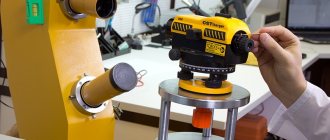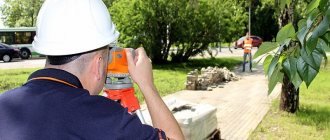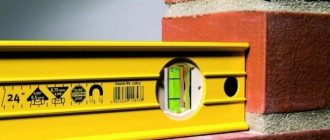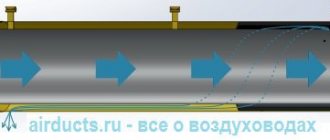For professional builders and surveyors, a level is a must-have device. It allows you to perform measurements and calculations with high accuracy.
A huge number of types of this device allows you to choose the appropriate option for most tasks, from simple home repairs to the creation of large architectural projects.
What is a level?
A level is a special technical device that is intended for measuring points located at a certain level when performing construction and geodetic work. This device is also used to lay out the axes of buildings and check the position of structures. Specialists such as builders and surveyors know how to use a level during construction.
The main task of this device is leveling, that is, building horizontal and vertical lines against which deviations become visible. When observing an object from an optical level, a grid of thin lines superimposed by the device becomes visible. It's called a sighting device.
In general, the essence of the leveling device and its purpose is to find the level of location of certain points relative to a certain base (object). This device is indispensable for planning the area before starting construction, for pouring foundations, and erecting walls. Also, in a room being renovated, the level is used for pouring floors, laying ceramic tiles evenly, and so on.
How to install the device during building construction Source chkiv.ru
Definition and classification
A level is a measuring device that is used to calculate the difference in the levels of points in space in relation to a conventionally specified surface. They are often used by topographers or surveyors when studying the relief, as well as by builders when it is necessary to strictly observe certain parameters when constructing or repairing objects.
These devices are needed wherever it is necessary to perfectly level the surface vertically or horizontally or to give a certain object or structure a certain level of slope.
They are classified according to two criteria: the principles of their operation and the accuracy of measurement.
There are three groups of devices based on the accuracy of reading parameters:
- high-precision - a square error in measurements per square meter of double stroke is allowed in the amount of 0.2−0.5 mm;
- accurate - the permissible square error is 0.5−1 mm per square meter of double stroke, respectively;
- technical - the error rate is 2−10 mm, respectively.
To perform basic terrain markings and determine differences in relief, as well as its binding to the desired points, you can use simple technical devices. But more accurate devices will be required to determine parameters at all stages of construction work.
As for the classification of levels according to the principle of operation , they are as follows:
- Geometric. Such devices emit a sighting beam and bring it to a horizontal position. With their help, the difference in the position of points on a particular area is established. These points must be marked using special slats. Geometric leveling can be simple or complex. In the first case, it is carried out from one point, in the second - from several that change progressively;
- Trigonometric. In another way, they are also called theodolites, and they are used to establish between elevation marks using an inclined beam. The angle of inclination and distance are measured between the device and the control point, and then, according to the formula, the required value is determined. This is quite difficult; over long distances or rough surfaces the result may be inaccurate;
- Hydrostatic. These devices consist of two vessels with liquid connected to each other. The difference in heights at different points is determined by the level of the liquid. Full vessels are connected to each other by means of a sleeve and a hose and placed at control points. The amount of excess of one point over another is determined by the difference between the height of the liquid column in each of the vessels. This method, although highly accurate, is limited by the length of the hose or sleeve;
- Optical-mechanical. With the help of such devices, the parameters of the points are determined using a light beam and slats marked in a special way. The devices have an optical tube for observations, as well as a device for leveling strictly horizontally. But to carry out measurements with them, you need to have a number of specialized skills and knowledge;
- Laser. These are high-precision devices in which a narrow beam is projected onto the surface using a laser. They are very easy to use; with their help you can work not only with points, but also with planes;
- Digital. Optical or laser levels that display information in digital form are capable of storing it, and in some cases even partially analyzing it. These devices are accurate and can be operated by one person, but are expensive and susceptible to mechanical damage.
Read also: Wrought iron hangers for the hallway wall photos
There are also special methods of leveling , they are carried out using devices such as:
- radars;
- barometers;
- echolocators;
- stereoscopes, etc.
However, all these methods are almost never used for domestic needs.
Design and types of levels
To understand why a level is needed in construction or repair conditions, it is worth taking a closer look at its structure. There are several types of levels: laser, digital, optical, hydrostatic. The main component of an optical-mechanical leveling device is a pipe with a special lens system. It rotates in a horizontal plane and has the ability to visually magnify objects twenty times or more. Using the flywheel, the device is adjusted for image sharpness. This occurs after a light beam passes through the lenses. The design of this device also includes:
- collimator;
- round level mirror;
- tripod (structure holder);
- round level adjusting screws;
- horizontal limb (used for constructing and measuring angles);
- round level;
- micrometer screws;
- tribrach (special stand for the main leveling unit - optical tube);
- lifting screws and bubble level (help to accurately calibrate the device when used).
In addition to the level, the kit usually includes a staff with marks applied to it. It is this that is held vertically at a certain distance by the surveyor’s assistant.
Design features of an optical level Source blogspot.com
See also: Catalog of companies that specialize in finishing materials and related work
The simplest and most cost-effective type of optical level remains a device with one or several cylindrical levels. Automatic levels perform measurements more accurately, but are more convenient for use on crushed stone and other unstable surfaces.
The operating principle of a laser level is based on the action of a laser beam. A conventional positioning device of this type is used mainly in enclosed spaces for repair work. Reason: the beam is difficult to see outdoors, especially in bright sunshine. If it is necessary to use a laser leveling device on a construction site in daylight, use a device with a green rather than a red beam or a special rotary device that constantly rotates the upper part (the operating angle is 3600, and the number of rotations is about six hundred revolutions per minute), forming more visible laser horizontal mark (line).
One of the types of laser levels is projection devices that work by marking the visible plane using a prism. Such leveling devices can be linear, point, or combined. Projection levels work well at a distance of about one hundred meters. Rotary devices can cover even more space.
Laser device for leveling Source bosch-tools.com.ua
Another modern type of level is digital. This is an optical-mechanical or laser device that outputs the received data in finished form to a special equalizer. For this purpose, such a level is equipped with memory, a processor and allows you to take measurements without the involvement of a partner.
The very first level is a hydrostatic device. It consists of two containers with liquid connected to each other by a flexible hose. This simple device works thanks to the physical law of communicating vessels.
How to choose a level?
When choosing a household laser level, there is no point in spending money on an expensive device, since even budget models will allow you to mark inside rooms of any size.
For this purpose, the minimum beam length will be sufficient.
In addition, the smaller the room, the smaller the angular errors will be.
It is enough to inspect the case for damage, and also check the laser level with a bubble analogue.
When choosing semi-professional models, as well as instruments for professional construction and geodetic activities, important parameters that you should pay attention to will be:
• Number of rays. To the standard two rays that build lines vertically and horizontally, several additional ones are added. As a rule, they are located on the sides of the device.
• Glow range. If this parameter, which is indicated by the manufacturer, is 30 meters, the rays will shine over long distances. But it should be remembered that when the specified range threshold is exceeded, their thickness increases, which leads to a decrease in the accuracy of the marks.
• Availability of a self-leveling system. This will save time on precise positioning of the device relative to the horizon.
• Beam scanning angle. It’s good if this parameter is 110° - 130°.
• Batteries. The simpler they are, the better. Ideally, the device will require two or three AAA batteries to operate. A rechargeable battery is also a good option.
• Additional accessories.
Some models are supplied with protective laser glasses.
They not only protect the eyes from the effects of radiation from devices, but in them the beam itself is better visible in any weather.
For comfortable work, you also need a tripod, especially in cases where the device needs to be raised to a certain height.
Level - complete set
To fix the level in various places, a “clothespin” type mount is required.
A more convenient option would be one with a universal magnetic mount.
A device with a rich set of components will cost more, but if you buy accessories separately, their cost will be even higher.
• The professional level is equipped with additional adjustments.
In particular, models with mini-tripods, which are located directly in the body, have smooth aiming screws, which allow you to configure the device as correctly as possible.
Level with mini tripod
Among other things, levels must have reliable protection from dust and other external factors.
The degree of protection can be determined by the markings.
IP54 is considered standard - a moisture-resistant device that is suitable for working in the rain and on a dusty construction site.
Professional level
To protect against falling, levels must have a shockproof housing and damper pads.
Some models are equipped with internal shock absorbers that protect electronic components from damage.
Usage
To learn how to use an optical level, you should master the following instructions:
- Set the tripod from the leveling device to the desired height using the three legs of its tripod.
- Press down the feet of the unit to firmly and firmly fix the tripod.
- Place the device on a tripod, securing it with a special screw.
- Having turned the device so that the two screws for adjustment (lifting) are in front of your eyes, on the sides of the measuring device, begin to rotate them until the bubble is on the axial mark.
Installation and adjustment of the device Source gis2000.ru
Where are optical levels used?
There are a lot of types of work related to measuring heights and unevenness, but here are the main ones:
- Geodesy
- Construction
- Pipe laying
- Landscape design
- Road construction
- Archeology
The most important thing is to decide why you need an optical level, in what conditions and on what terrain you will work with it. There are basically 4 types of work:
- Common leveling tasks. Optical levels for such work are assembled and designed for the simplest leveling and measuring tasks. Almost all technical levels can cope with this type of work and are the cheapest.
- High precision leveling tasks. Tools developed for this type of work can make more accurate measurements. Most class 2 and 3 levels will be able to perform tasks at this level, even on strong slopes.
- Advanced Leveling Problems. Such work includes all construction work on an industrial scale. The level must have very high accuracy with minimal error. Tasks of this level can be performed by class 1 devices and some class 2 levels with the proper additional equipment.
- Highest precision leveling tasks. Types of such work include geodesy and archaeology. For these tasks, special devices are created with maximum magnification and accuracy, as a rule, these are class 1 levels with the best characteristics; levels of this level can cost from 50 thousand rubles. and more.
Briefly about the main thing
A level is a device for measuring the level of points in space. Used for construction and repair work.
There are three main types of leveling devices - hydrostatic, laser and optical.
The type of level is chosen depending on the required accuracy of the upcoming measurements and the location where they will be taken.
To operate a laser level, you need power from an outlet or battery, and for an optical level, you only need a special staff with divisions marked on it. The digital device is capable of independently adjusting or measuring levels.
When installing, configuring the device, as well as during measurements with its help, you must adhere to safety precautions, operating rules and transportation of the device.
Ratings 0
The principle of operation of an optical level during shooting
Let us consider the process of leveling class IV using the so-called “middle thread” method. First of all, the device is brought into working condition using a contact or cylindrical level.
Then the telescope is pointed at the surface of the black side of the rear rail and the level bubble is brought to the mentioned “zero point” (using lifting or elevator screws). Now the rangefinder and middle strokes allow you to take a reading.
Then we shoot in the same way by pointing the telescope at the surface of the black side of the front staff, then at the surface of the red side of the front of the staff, and finally along the surface of the black side of the rear of the staff.
When using an optical level with a compensator, the first thing to do is to install the device in the working position and check the normal operating condition of the compensator. And only then can you start shooting.
During the survey, all observations must be recorded in a field journal. It’s even more convenient to use the recorder’s storage device for these purposes.
If a difference in excess values of more than 5 mm is detected, repeated measurements are necessary, and in this case it is necessary to change the height of the device by at least 3 cm. When completing field work, it is necessary to calculate the discrepancy along the line between the original benchmarks.
Its value should not be higher than 20 mm. The results of field work are entered into a special record of excesses. Today there is no alternative to using an optical level, so in the coming decades this tool will be absolutely indispensable when carrying out geodetic work.
Additional devices and equipment
In addition to the device itself, for work we will need the already mentioned tripod, as well as a special measuring rod with divisions and numbers printed on it. The divisions are stripes of alternating black or red stripes 10 mm wide.
The numbers on the rod are marked in increments of ten cm, and the value from zero to the end of the rod is in decimeters, with the numbers expressed in two digits. So, 50 cm is designated as 05, the number 09 indicates 90 cm, the number 12 indicates 120 cm, etc.
For convenience, the five centimeter marks of each decimeter are also united by a vertical strip, so that the entire strip is marked with signs in the form of the letter “E”, straight and mirrored.
Older models of instruments give an inverted image, and they require a special rack with inverted numbers.
Auxiliary devices for the level
A passport is attached to the level, which must indicate the date of its last check and adjustment, or, as surveyors say, “verification”. Levels are checked at least once every three years, in special workshops, about which another entry is made in the passport.
In addition to the passport, the level kit includes a key for maintenance and a soft flannel for wiping the lenses and, of course, a protective case where it is stored. Models with a horizontal dial - protractor - are equipped with a plumb line for installation exactly at the desired point.
Protect the level from shocks and shocks, even when it is in its case. Modern devices are equipped with a special device that performs precise horizontal adjustment; a strong push, which does not leave the slightest trace outwardly, can damage its delicate mechanism.











